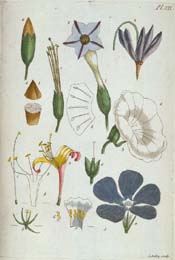
Bindweed, GreaterBotanical: Convolvulus sepium---Synonyms---Hedge Convolvulus. Old Man's Night Cap. Hooded Bindweed. Bearbind.---Habitat---The Greater Bindweed, or Hedge Convolvulus (C. sepium), is a hedge plant found abundantly throughout England and Scotland, but only of local occurrence in Scotland. Like the Field Convolvulus, it is, in spite of the beauty of its flowers, regarded as a pest by both the farmer and the gardener, its roots being long and penetrating in a dense mass that exhausts the soil, and its twining stems extending in masses over all other plants near, and strangling them to a still greater degree than its smaller relative
---Description---The leaves of this Bindweed are arrow-shaped and large, somewhat thin and delicate in texture. They are arranged singly on alternate sides of the stem, as is the case with all species of Convolvulus and from their axils spring the flower-stalks, which are square and in every case bear only one large blossom, conspicuous for its snowy whiteness. The flowers are among the largest which this country produces. The calyx is entirely hidden by the two large bracts that enclose it, and which completely hide the flower while in bud, a feature that has gained it also the name of 'Hooded Bindweed,' and has led some botanists to place it in a different genus, Calystegia, the name being derived from two Greek words signifying 'beautiful covering.' The specific name, sepium, is derived from the Latin sepes, a hedge, andrefers to its place of growth. The flowers are in bloom from July to September, and like all the other species expand during sunshine and remain closed during dull weather. They do not, however, like those of the Field Convolvulus, close during a shower. Anne Pratt (Flowers and their Associations) notices the fact that while some twining plants follow the apparent course of the sun and turn round the supporting stem from left to right, others, like the large White Bindweed or Convolvulus, twine contrary to the sun, from right to left, and never otherwise; even if the gardener turn it in another direction, the plant, if unable to disengage itself and assume its natural bias, will eventually perish. © Copyright Protected 1995-2004 botanical.com
|
|
| GuestBook |
STUMBLE-UPON: NATIVE AMERICAN EMBASSY: HOME PAGE:

|
Copyright(s) © 1991-2012: Lenni Lenape Phoenix, Native American Embassy, Mandy & NATIVE ENIT, Native American Holocaust Museum, Inc., Minister Jessie Renee (Von Noaker) ThunderWolfe, Priscylla Belle Venticello, Von Noaker Family Publishing Group International North American Homeless Ombudsman Council
Copying in any form or medium is strictly forbidden without prior written permission: Illegal copying (Taking Possession of) anything within this Web Domain contitutes "Criminal Theft of (Intelectual) Property & will be treated as such! |
|
|
|
VISITOR STATISTICS: TREEPAD
|
|
CONTACT INFORMATION: NATIVE AMERICAN EMBASSY 1413 Union Avenue McKeesport, Pennsylvania 15132 USA PHONE: [VOICEMAIL ONLY HOTLINE (News, Reports, etc.)]: (412) 436-3866 Pennsylvania, Pittsburgh Office: (412) 689-9051 Pennsylvania, Johnstown Office: Private: Auto Transfers To Hawaiian Office HAWAIIAN OFFICE & MAIN NORTH AMERICAN (U.S.) OFFICE: (808) 445-6576 NEW YORK OFFICE: (631) 913-3475 OKLAHOMA OFFICE: (405) 225-6124 |
|

